Matsuri Times
Circa 2010 -2013
The Matsuri Times detailed some of the most famous and fascinating Matsuri events throughout Japan. Spring and summer are especially popular seasons for festivals. It was a subjective guide to Japanese festivals - collection of photography, videos, and stories from various events in Japan.
Content is from the site's 2010 -2013 archived pages. This website was selected for its historical significance by the Web Archive Project, which then funded its restoration and archiving for use by educators. TNG/Earthling's CEO Bob Sakayama provided pro bono technical assistance along with Rev Sale who handled code development. Research for the restoration was handled by OneInAmelia.
Japanese Festivals
Nagahama Hikiyama Matsuri – children kabuki theater
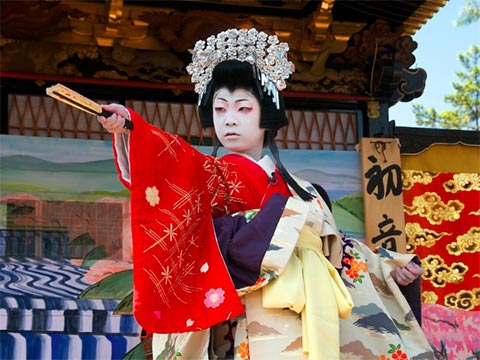
Kodomo kabuki (“children kabuki”) performances are the highlight of the festival in Nagahama, Shiga Prefecture. Every year on April 15th, children perform theatrical plays on movable stages.
Like in real kabuki theater, boys perform both male and female roles and like in real kabuki, they fully engage in their acting. They even have a loud claque applauding their appearances and poses.
In 2013 four classical plays were played by boys from 6 to 12 years old.
It is worth mentioning, that the performances deal with no laughing matters. Children appear in the same plays as adults do and scenes include things like killings, head viewing, and another creepy topics. Nevertheless in a real Japanese fashion such “heavy” events are usually explained between the scenes.
There are 12 platforms with kabuki stages in the town of Nagahama. During the festival four platforms are used for the performances. A single neighborhood participates in Hikiyama Matsuri every three years.
One neighborhood has a special platform called Naginata-yama which is not used for theatrical plays. Instead the group re-enacts a historical warrior parade to the Hachiman Shrine.
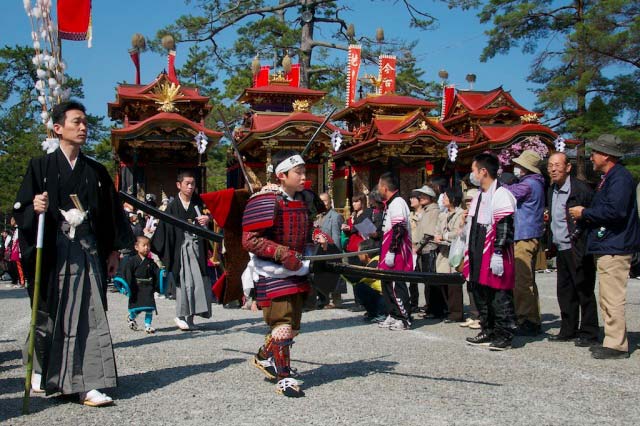
Practical information
On the main event day, April 15th, the festival starts with the historical parade to Nagahama Hachiman-gu shrine. Each team playing kabuki also starts with their first performance in the shrine. Then they proceed to otabisho staging the play twice in the shopping street to end with an evening performance in front of the mikoshi in otabisho.
Surroundings
The castle town of Nagahama was developed by Toyotomi Hideyoshi after he was granted land here in late 16th century. His castle stood here for about 20 years, but was dismantled in early 17th century and its materials were used to expand nearby Hikone Castle.
Nowadays in the place of Nagahama Castle there is a historical museum in a castle-like, concrete building. It offers a nice view and information, but the building itself has no historical value.
If you came to Nagahama specifically for Hikiyama Matsuri, skip the festival museum, it doesn’t really add anything to real experience.
Daigoji Cherry Blossom Viewing

Daigo-ji Temple (醍醐寺) now in Yamashina Ward of Kyoto City was a famous place for cherry blossom viewing several hundred years ago. Unfortunately most of the temple buildings were destroyed during Onin War (1467–1477) and only five-story pagoda remained. In 1571 an imperial family member entered the Buddhist priesthood by the name of Gien (義演), assigned to Daigo-ji he tried to revive the temple and managed to rebuild one of the buildings. In 1580 he became the abbot of the temple and later advanced in his career as a Buddhist priest.
Using his personal connections he supported Toyotomi Hideyoshi – a strong military leader of that time. Gien, using his personal connections managed to help Hideyoshi acquire the title of kampaku – kind of regent – which officially made him the most powerful man in Japan.
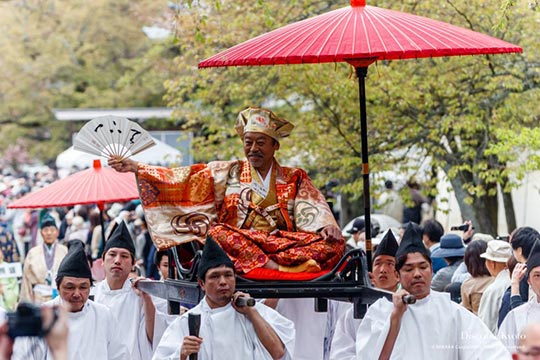
Hideyoshi, who later retired from the post and assumed the title of taikō, did repay his debt in 1598. Only a few months before his death, he organized a huge and lavish cherry blossom viewing party for the elite of Japan.
On that occasion, Hideyoshi ordered several hundred cherry trees to be planted and also a relocation of the main hall of Manganji Temple in Kii Province (currently in Yuasa, Wakayama Prefecture) which was rebuilt as Kondō of Daigo-ji.
It is in front of this building that every 2nd Sunday of April a simple re-enactment of the hanami cherry blossom viewing takes place.
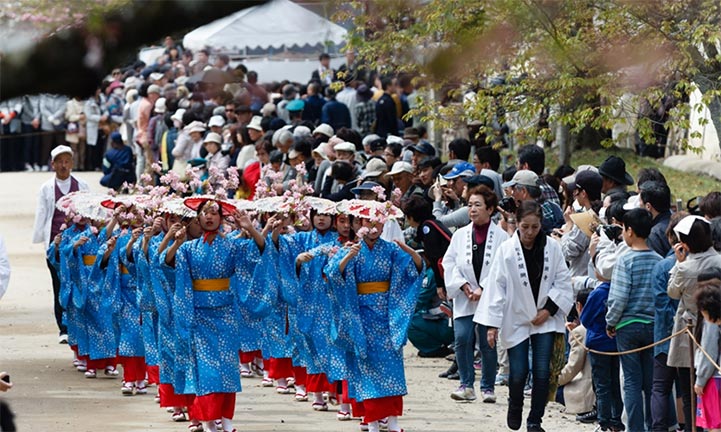
Practical information
The festival has three parts.
- ceremonies in Sanpo-in (三宝院) hall – not available to the general public
- a parade from Sanpo-in to the temple main hall Kondo (金堂) – in a “free” area between the gates
- main events with bugaku, dance, and other performances in front of the Kondo – inside paid area of Daigo-ji.
Sagicho Matsuri – fire festival in Omihachiman
Sagicho Matsuri is one of Japan's three most dangerous festivals! Noisy, colourful, dangerous, drunken! What more do you need in an event?
Held on a mid-March weekend, in Omi-hachiman, Shiga-prefecture over 2 days. Saturday sees a parade of floats from each district in the city; while on Sunday, the floats clash in a fighting display before being torched. Get in amongst the action and fun though take care not to get squished or scorched!
Sagicho Matsuri in Omi-Hachiman City dates back to medieval times. It is said that Oda Nobunaga (a powerful warlord who ruled Japan in 16th century) enjoyed this festival himself.
At those times, the festival was held a short distance from current place, at the foot of the Azuchi Hill where Nobunaga’s huge castle stood. After his death and burning of the castle, the townspeople moved to the current place where general Toyotomi Hidetsugu built his fortress.
It is one of the most crazy Japanese festivals requiring laborious preparations of the decorations only to burn them in one evening.
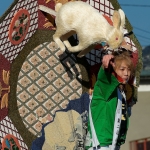
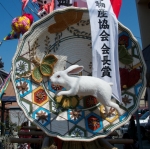
The origins
Sagicho is a pile of straw or a ceremony in shrines during which new year’s decorations (also made usually made from straw). Such events (sometimes called “tondo”) are held throughout Japan on January 15th or 18th, but in some places however the ceremony became more and more elaborate and was moved to a different day. Such is the festival of the Himure Hachiman Shrine which became a yearly festival of the townspeople of Omihachiman.
Each of the thirteen neighborhoods of the old castle town prepare their own platform. Each is decorated with an edifice of a different animal from Chinese zodiac.
Platforms weigh up to 1.5 tonnes and are carried on shoulders. Their bases are a huge piles of straws with wooden frame. The decorations are made using food ingredients like beans, dried seaweed, noodles. Neighborhoods compete for the best decoration each year.
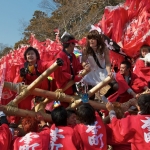
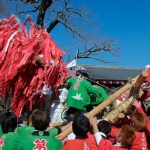
Each of the thirteen neighborhoods of the old castle town prepare their own platform. Each is decorated with an edifice of a different animal from Chinese zodiac.
Platforms weigh up to 1.5 tonnes and are carried on shoulders. Their bases are a huge piles of straws with wooden frame. The decorations are made using food ingredients like beans, dried seaweed, noodles. Neighborhoods compete for the best decoration each year.
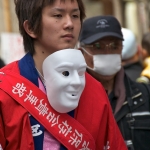
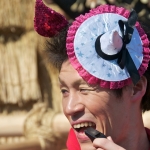
Ashes to ashes
The most disturbing thing about Sagicho Matsuri is that all those decorations that took months to prepare are burnt in one evening.
The festival in 2011
Sagicho Matsuri in 2011 took place the day after the Great Tohoku Earthquake. It was the beginning of the Year of the Rabbit which was supposed to bring a calm and peaceful times after the previous Year of the Tiger. It did not.
While Shiga Prefecture was not hit directly by the earthquake or tsunami, those events had a huge impact on everyone in Japan at that time. When the time for burning the decorations came on Sunday evening, people immersed in a fury against the symbol of the year that brought the disaster. They beat and burnt the images of the rabbit. The contrast between the cute images of rabbits and people releasing their aggression against them was surreal.
DATE: 3rd weekend of March
10:00 – 22:00
Practical information
Omi Hachiman Sagicho Matsuri takes place on the third weekend of March in the old town area of the Ōmihachiman cityaround Muro-Hachiman shrine (牟呂八幡社). The nearest train station is JR Omihachiman which is barely 35 minutes from Kyoto on regular express train. It takes about 30 minutes by foot to reach the shrine, but you might encounter festival activities on the way.
Saturday is for parade and platform decorations contest, but there is a lot of lively dancing anyway. Sunday is when violent things start to happen. It is the day that fight “kenka” starts and decorations get broken.
The climax of the festival (Sunday evening, on the premises of the shrine) is attended by large number of people, but surprisingly very few people visit the town during the day.
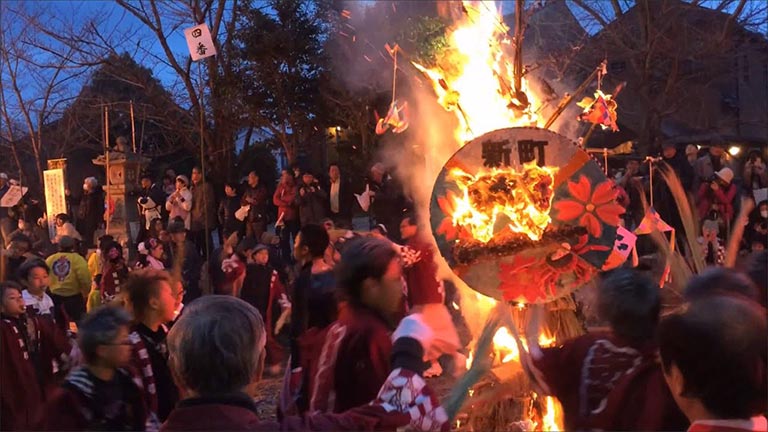
Naked Festival in Okayama – Saidaiji Hadaka Matsuri
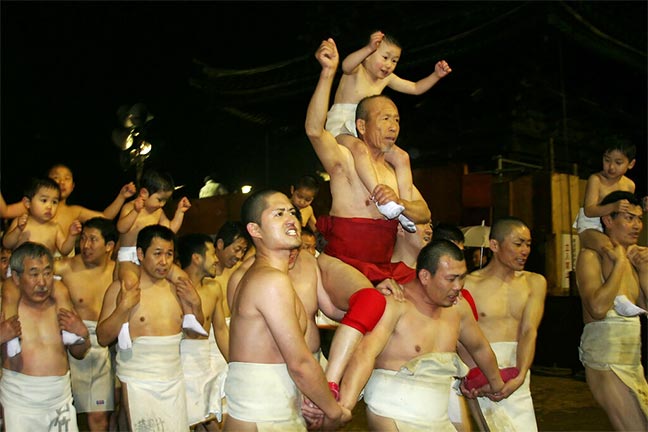
Hadaka Matsuri is a common name for the “naked festival.” Such events are held all over Japan and throughout the year. Depending on a place their concept and rules differ. Two most famous Hadaka Matsuri take place in winter in the vicinity of Nagoya and in Saidaiji Temple in the city of Okayama in western Japan.
Okayama naked festival
Naked men festival in Okayama is officially called Saidaiji Eyo and started over 500 years ago. The idea is that at midnight an amulet is dropped from one of the temple buildings and the man who manages to snatch it will have a lucky year.
Initially the festival did not have anything to do with nudity. Some old drawings show pilgrims fighting for the shingi fully dressed. It is said that when a festival got popular and competition became more fierce, clothes were simply obstructing and got torn.
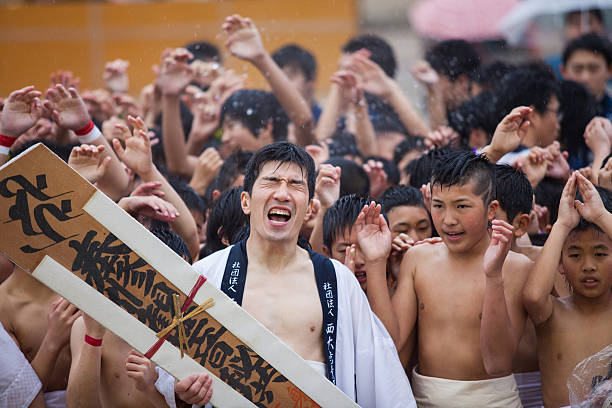
Practical information
- The festival ends at 22:00 not midnight – for 499 years the main event of the festival was scheduled for midnight. In 2010 it has been changed to 22:00 to let people use public communication to return to the city, it has been continued thereafter.
- Buy a ticket – there is practically no other way to watch the main event except from the stands facing the main hall of the temple, there are seats and standing places behind.
- But don’t buy a reserved seat – although probably all will be already sold out, you don’t want to be glued to your seat for the whole evening. Its February and its evening. You won’t see much and you will freeze!
- Arrive early – although main events are in the evening, groups of younger participants run on the premises of Saidai-ji Temple for the whole afternoon
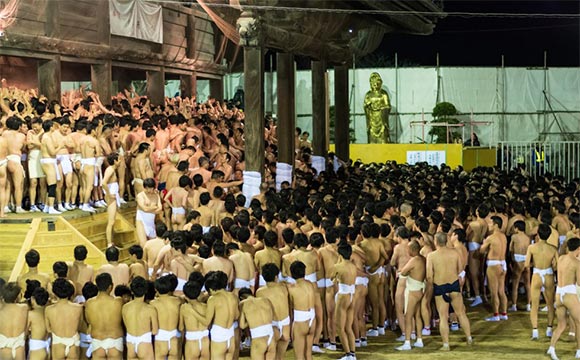
Asuka Onda Matsuri – Rice, Fertility and …Spanking
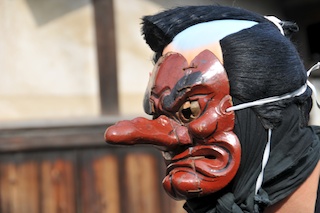
Onda Matsuri and Ta-asobi—literally “playing in the field”—are one of the oldest festivals in Japan. They are held in winter or early spring and serve as a way to preserve and pass the knowledge of rice cultivation from generation to generation.
During those festivals a religious ceremony praising five grains of Japan takes place. It is usually followed by a pantomime of planting rice on the field. To entertain the audience some gags are put into the performance.
In addition such festivals often feature some kind of play related to human fertility serving as a way of sex education.
In Asuka Village the Onda Matsuri festival is accompanied by a strange custom of spanking people by masked men.
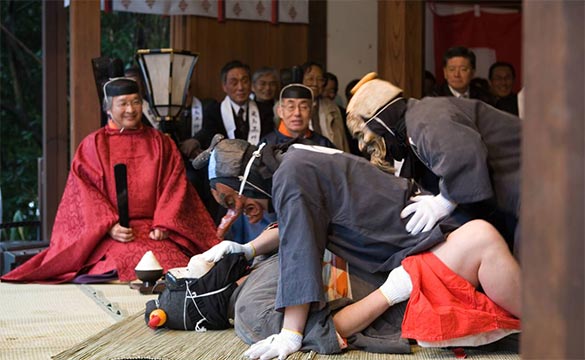
Practical information
Asuka Onda Matsuri festival is held in Asuka Niimasu Jinja (飛鳥坐神社) shrine. The closest station Kashihara Jingu-mae on Kintetsu Railway (attenion: there is a station called Asuka, but it is farther away from). From station you can walk, but it is quite a distance so you might consider renting a bicycle at the station.
Except for the area around the station, it is a real rural area with no restaurants in vicinity, though during the festival you might find some shops offering meals.

Aoi Matsuri – probably the most boring festival in Japan
Kyoto Festival: Aoi Matsuri
Considered one of the three most important festivals in Kyoto, the Aoi Matsuri takes place on the 15th of May each year. Held by the important Kamo shrines, Kamigamo Shrine and Shimogamo Shrine, the origins of the festival can be traced all the way back rites performed to appease the gods and pray for bountiful harvests in the 6th century. It was established as a more formal annual event in the 9th century Heian Period when Kyoto became the capital and the Emperor recognized the importance of the Kamo shrines to the capitol's prosperity. Because of the aoi, (hollyhock) leaves pinned to the participants' hats, clothing, and carts, it earned the colloqial name of Hollyhock Festival over its original Kamo Festival title.
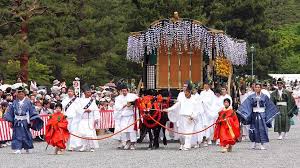
Leading up to the Aoi Matsuri are many interesting and exciting pre-rituals and ceremonies, but the main event is the grand parade on the 15th. Starting from the site of the former Imperial Palace hundreds of participants dressed in Heian Period clothing form two processions and make their way to Shimogamo Shrine and then on to Kamigamo, performing rites and making offerings at each. The first procession is the Imperial Messenger's, accompanied by court nobles, soldiers, and offerings. The second, the Imperial Princess', is made up of noble women, ladies in waiting, and priestesses. A stately and aristocratic parade, watching the Aoi Matsuri go by while listening to the ox carts distinctive creaking allows the viewer to feel like they've been transported back in time to the Heian capital. We at Kyoto Fan certainly did!
Aoi Matsuri held in the first half of May with the main event on May 15th is considered to be one of the three great festivals of Kyoto, together with Gion Matsuri in summer and Kyoto Jidai Matsuri in autumn.

Aoi Matsuri (葵祭) means “Hollyhock festival”,
but the official name of the event is Kamo festival.
Two-leafed of hollyhock plant is the coat of arms of the Kamo Shrine.
Like other festivals, Aoi Matsuri combines religious ceremonies with events open to the general public. It reaches its climax with a parade from Imperial Palace to Shimogamo Shrine and then to Kamogamo Shrine.
However, unlike folk festivals that entertain people with music and performances, Aoi Matsuri is a festival of aristocracy and is held in a solemn atmosphere. Silence is broken only by the squeaking sound Imperial ox cart (goshoguruma). In result, on a usually beautiful spring day on the streets of Kyoto a sad, moving show of make-up and paper flowers takes place.
Thousands of viewers wait along the way to compare reality with a drawing in a folder that they previously bought. It matches perfectly. There is no place for improvisation, music nor even a speck of fun.
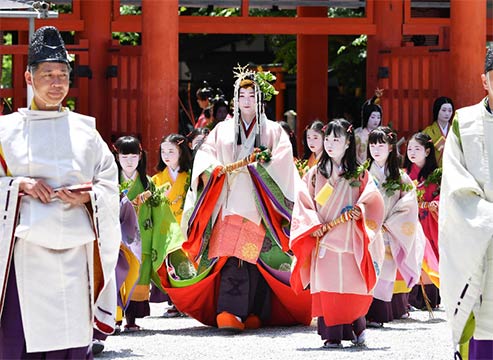
Aoi Matsuri is said to be the oldest festival in Kyoto, but its form has changed over time. There were even periods when it waned and disappeared entirely from the calendar.
Its current form was established only 55 years ago
Procession leaves the Kyoto Imperial Palace and proceeds to Shimogamo Shrine. There the religious rites not open to the public are performed. At the same time a competition of yabusame horseback archery is held in the park in front of the shrine. In the afternoon participants go along Kamo River to Kamigamo Shrine.
Though the parade of Aoi Matsuri looks like a single procession, in fact, participants are divided into two separate groups commemorating different historical events.
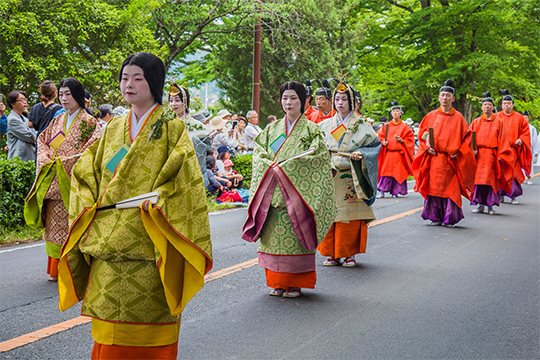
Procession of an Imperial Guard Representative
The first part of the Aoi Matsuri procession features a parade of Konoe-tsukai – an Imperial Guard delegate as well as a few other high-ranked notables of the Imperial court.
Procession of an Imperial Princess
In the old times one of the female members of the Imperial family of Japan had to serve as a maiden in the Ise Shrine (a few days of walk from Kyoto). The preparations for this event and transfer of the princess to the shrine were hugely celebrated events.
The procession of Imperial princess during the Aoi Matsuri is a re-enactment of a parade.
Nowadays each year a young lady from Kyoto is chosen to became a Saio-dai (斎王代), who plays a role of the Imperial princess.
DATES: May 15th
10:30 – 15:30
Practical information
In the morning procession starts from the Imperial Palace and proceeds to Shimogamo Shrine, in the afternoon it moves from Shimogamo Shrine to Kamigamo Shrine. There are paid stands along the main road on the premises of Shimogamo Shrine.
Don’t bother buying a seat. You will be glued to one place in a distance to the procession, with people sitting in front of you (better places are already sold out) and in the back (you won’t be able to stand up), in a relatively dark place (inside the forest).
The afternoon parade gathers less visitors and takes place in a better setting – participants walk along the bank of the river, not among buildings.
